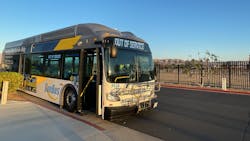SunLine welcomes five new hydrogen fuel-cell buses, advancing hydrogen projects
SunLine Transit Agency (SunLine) is launching five New Flyer Xcelsior hydrogen fuel-cell buses into service within the agency’s fleet, continuing SunLine’s history of incorporating the clean and efficient technology into its service.
These buses, along with other hydrogen initiatives, come in time for National Hydrogen and Fuel Cell Day, Oct. 8 – which appropriately matches the atomic weight of hydrogen (1.008).
Upon the fifth delivery from New Flyer, SunLine will be in possession of 21 total hydrogen fuel-cell vehicles. This arrival keeps SunLine on track to convert all vehicles to zero emissions by 2035 – five years ahead of the deadline set by state mandates.
With zero tailpipe emissions generated by a hydrogen fuel cell bus, these vehicles allow the Coachella Valley to maintain a clean environment while continuing to get riders where they need to go. This addition of American-made hydrogen fuel-cell vehicles pushes the agency one step closer to full zero-emission status.
SunLine’s growing hydrogen fuel-cell fleet is made possible by an ongoing investment in onsite infrastructure, including one of the largest hydrogen fueling station dedicated to transit in the U.S. – the PEM Hydrogen Electrolyzer.
The Electrolyzer allows the agency to manufacture its own hydrogen production, offering a bundled fleet and electrolyzer-based fueling solution that paves the way for and accelerates mass adoption of fuel cell buses and trucks in fleet operators. This, in turn, drives down the total cost of ownership of fuel cell bus and truck fleets, making it an impactful program for propelling long-term reductions in carbon footprints and greenhouse gases throughout the country. This technology has allowed SunLine to convert its entire fleet to zero-emission vehicles five years ahead of the state mandate.
SunLine has taken on initiatives that have allowed the agency to become a testbed for hydrogen fueling infrastructure, fuel cell technology development and commercial operation of fuel cell buses. As a pioneer of hydrogen technology in relation to fueling zero-emissions buses, SunLine Transit says it serves as a model for other transit agencies around the country. By leading the way in the conversion of its zero-emissions fleet, SunLine notes it creates a path for other agencies to learn how to implement hydrogen technology to benefit the environment in their communities.
The agency has also forged several partnerships in renewable energy projects to help fulfill its vision for the future of clean fuels—not only in how they are made, but how the technology will be integrated into transit agency operations throughout the country.
Among SunLine’s partnerships is NICE America Research. This group has established liquid H2 pump technology and a mobile refueling system. This removes barriers impeding widespread use of hydrogen fuel cell vehicles for transportation purposes. The NICE liquid hydrogen system reduces operating costs to a comparable level to that of diesel-powered buses and takes about the same time to refuel. This technology offers hydrogen stations in the form of a mobile trailer allowing use without a permanent station structure and cuts down the cost and time it would take to build permanent hydrogen stations.
SunLine began filling buses using this system at its Indio facility earlier this month.
Costs are covered, in large part, by grants like the Zero-Emission Transit Fleet Infrastructure Deployment grant from the California Energy Commission. This grant awarded SunLine more than $4 million towards expanding its hydrogen fueling capabilities to include a stand-alone liquid hydrogen station.
The new liquid hydrogen station will include liquid storage, a vaporizer, compression equipment, gaseous storage and dispensing equipment. It will also provide both capacity and resiliency for existing and future fueling infrastructure alongside the agency’s hydrogen electrolyzer. Together, the hydrogen electrolyzer and liquid hydrogen station will be capable of fueling 57 fixed route fuel cell electric buses and 39 paratransit fuel cell electric buses. The completed station is expected to be operational by the end of 2023.
As SunLine continues to implement advanced technology, the agency paves the way for other organizations to do the same. One example of this is Southern California Gas Co. (SoCalGas) groundbreaking technology that produces hydrogen from renewable natural gas at SunLine’s hydrogen fueling station in Thousand Palms. The research project, called H2 SilverSTARS, will produce renewable hydrogen to fuel SunLine’s fleet of hydrogen fuel cell electric buses and support further expansion. The combination of new technologies will make it possible to provide renewable hydrogen made from renewable natural gas at any location near a natural gas pipeline. The goal is to produce emissions-free renewable hydrogen for fuel cell electric cars and other vehicles at a price competitive with gasoline. This project will break ground at the end of 2021.
“SunLine has always strived to push forward the boundaries of the transportation sector,” said Lauren Skiver, CEO/general manager of SunLine Transit Agency. “The necessary infrastructure and investments we are making today – coupled with our close proximity to the I-10 corridor – will enable the entire transportation sector to benefit from our investments for years to come.”
To date, SunLine’s current fleet is composed of three fuel methods: hydrogen fuel cell, battery electric and compressed natural gas (CNG) vehicles. In adherence to the SunLine Rollout Plan, all new fixed-route vehicle purchases will be zero-emission buses. Since each bus will operate for their entire useful life of 12-14 years, the remaining CNG buses will stay in operation until the end of their useful lifespan.



